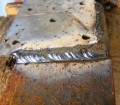Maintaining your knife in the field is a lot more important than you probably think. Even though they are made of steel and wood or some sort of synthetic hard handle, they can be damaged rather easily. A bit of simple care can extend the life of your blade and help to ensure not only your safety, but to give you many years of enjoyment and adventure with your knife.
Take care of your knife and it will take care of you. Simple as that.
When I am in the field, I carry three sharpening implements for my knives. None are super high-speed or expensive, and they all serve a specific purpose. First is my Smith’s Pocket Pal. I have had one or seven of these little guys for many years in my pack and I highly recommend them to any outdoorsman. They are simple, fast, and safe for those times when you are fatigued, and should not be trying to perform and fine tasks with your knife. The Pocket Pal has a carbide edge to sharpen and shape your blade, and a ceramic edge to hone your blade. The pocket pal also features a diamond coated rod for serrated blades and gut hooks, but I have only needed to use it to repair a few damaged knife edges.
Second for the knife is a 600 grit Arkansas stone for more detailed sharpening of my knife. I rarely use this stone because I tend to keep a well-honed edge on my knives and usually only have to maintain that finer edge. When the rare occasion comes that I do need to use my 600 stone, I soak it in water prior to use. Some folks prefer oil, but I am partial to water for simplicity and the fact that it works well enough for me.
Third implement for my knives is a small 1200 grit Arkansas stone for honing my blades. After maybe 15 passes on each side, my knife is ready to return to duty and will shave hair off your skin if you are so inclined.
Once I have finished my work for the day and get a chance to enjoy the fire, I break out the stones and get to work. As is with anything made of high-carbon steel, my knives tend to rust if not protected. While there are a million and one solutions for knife oils and conditioners and other stuff, I prefer the K.I.S.S. method. I use natural oils that I can eat. I don’t want to put anything on my blade or handle that I would not be willing to put on my mouth. After an incident involving a heavy wipe-down using a Tuff-Cloth and some summer sausage, let’s just say that I will be sticking with my tried and true veggie oil. Simple, but it works. I keep it in a small Nalgene bottle in my pack and it has many used other than knife care. Rub some on the blade before storage, and I know it will be ready for another inadvertent fall into the river.
Next is handle care. I prefer to use bee’s wax on my wood handles and to simply keep my micarta and G10 handles clean and debris free. The bees wax is another element that I am willing to ingest and it smells good too. Not that I am worried about smelling good….
Sheath care can mean the difference between your knife always being by your side and that panicked feeling of an empty space where your life saving tool should be. Leather, Kydex, cheap plastic, whatever your sheath is made of, it needs maintenance. Keep your Kydex clean and debris free. If your sheath does not have a drain hole, drill your own, and shoot an email to the manufacturer asking them why they didn’t do it. Leather sheaths have a few of their own issues, and require some specialized tools to keep them serviceable. I keep my speedy sticker and twine handy in my pack in case I pop a stitch. As soon as you notice it, fix it. You do not want to let it keep unstitching and lose your knife. I like to use the bees wax on my leather as well, but over the last year or so I have been using Fixin’ Wax from The Pathfinder School. It is softer and more pliable to use and is still mostly bee’s wax, which helps me to maintain my lovely smell.
After regular use of your knife, it will develop a patina that will become something your knife’s fingerprint. This unique pattern of patches and discoloring helps to tell the story of your knife. Minor rusting may occur from time to time, but is not a problem unless it leaves behind a pitting on the blade. I tend to use creek silt or a similar natural abrasive to clean off the rust in the field and finer scouring pads at home. Use caution when cleaning your blade because it should be very sharp.
When storing your blade for long term, take it out of the leather sheath if so equipped. The leather can absorb humidity and cause rusting on the blade which can cause irreparable damage if left long enough. Oil or wax the blade and handle and store in wax paper or similar material.
Basic knife care and maintenance is vital to the survivability of the knife and its user. If you neglect your knife, you may pay for it with your life. Take care of your knife and it will take care of you. Simple as that.


